“With limited resources and near-unlimited time, Kerrick used parts from one beast to build another.” – flavor text, Phyrexian
Broodlings
Mirrodin Besieged has been gradually spoiled over the past couple of weeks (it will likely be completely spoiled as of the publication of this
article), and one of the most polarizing cards has been Blightsteel Colossus, or as I like to call him, “One-Shot the Robot.”
For those of you who haven’t seen the card (or its inspiration), I’ll reproduce them here.

Wow. Those are some big, metal guys. At first glance, the new guy seems exciting. Huge, splashy cards can be a lot of fun, especially flavorful ones,
and references to old cards can serve as a knowing wink to the player that “yes, we know you weren’t born yesterday.” References are
an especially potent tool when a block is revisiting an old location (Mirrodin in this case).
Slam dunk, right? Wrong. Reaction to the new Colossus has been mixed. People haven’t all vocalized it the same way, but the general feeling
amongst its detractors is that it’s “too much,” like an ill-advised breast enhancement surgery that crosses the line into
unseemliness and comedy.
Is
Blightsteel Colossus a hack design, or just good ol’ fun? Well, let’s talk about it. Here are my thoughts on the BSC.
1. The card name has some problems and adds to the feeling that it’s a hack design job.
“Phyrexia wastes nothing. Its food chain is a spiraling cycle.” – flavor text, Phyrexian Ghoul
The name “Blightsteel Colossus” isn’t exactly a Magellan-level departure from the original. I actually feel sorry for the creative
team that worked on this because Darksteel cards are jammed into the “Compact Only” spaces in the naming parking lot—they all
typically have the prefix “Darksteel” and then a suffix. Thus, spinning off a Darksteel name is really difficult. The name they came up
with (and I was one of the people working on this) was Blightsteel Colossus, and it’s functional. That’s about it.
The name seems to suggest that infected Darksteel is known as Blightteel, an idea thus far absent from other spoiled cards. That seems a little cute
for Phyrexians. It doesn’t help that infect is all over the place thematically in terms of what it does, on occasion seeming to be a disease,
other times a poison, other times a drought or general dilapidation (or “blight”).
The need to keep the “Darksteel” reference intact (to flavor link to indestructibility) ended up ruining the name, as it’s not easily
understood whether this is an infected Darksteel Colossus or a new Phyrexian creation, made from scratch out of “Blightteel.” It turns out
the former is the case (according to Mark Rosewater’s Twitter, unless I’m misunderstanding him), and in that case the name should’ve been
“Blighted Colossus” or something similar. (Phyrexian Colossus would’ve been the perfect name, but unfortunately that one was already
taken.)
Compleated Colossus? I don’t know. It’s a real challenge. Considering how obvious a reference the card is, I think perhaps the name could
have taken a few more chances and departed from the original. The art and text box would have brought it home, and perhaps the card would have seemed a
little more “clever” and less of a flavor sledgehammer.
The name Blightsteel Colossus was one minor change too many on a card filled with minor changes. It’s a one-syllable name change on a card with a
one-word rules text change and a one-increment casting-cost change.
I’ll believe you if you say you weren’t being lazy, guys, but I don’t think you can blame people for thinking so. (If anyone has
alternative naming suggestions for this card, feel free to chime in on the forums.)
2. The infect ability doesn’t make any sense on an 11/11.
“Phyrexia strives to simulate natural life, but it can’t resist improving on the design.” –flavor text, Cystbearer
For the sake of the Darksteel Colossus reference, the designers of this card have held on to the 11/11 stats of the original. This is understandable
for flavor reasons, but as a result, the infect ability is a departure from the way it works on other cards and as such feels rather “tacked
on.”
Infect has an incremental feel to it in terms of how it plays out in games. Infect creatures have never been known for their sturdiness and often take
the forms of diminutive creatures like insects or Myr (who are not exactly known for their stature). In the case of every infect creature, you can take
a look at the card and understand how infect works, flavor-wise.
A couple of examples:
Cystbearer – It has infectious cysts all over its body.
Contagious Nim – As the name suggests, it’s contagious and carries an airborne or bloodborne Phyrexian taint.
Lol, Phyrexian taint.
Sorry, where was I?
Oh yeah.
The point is that while infect’s flavor link has always been a little loose in terms of exactly what is going on, typically the creatures have
had the feeling of insects, parasites, or apocalyptic “bite you and you’re infected” zombies.
An 11/11 doesn’t fit anywhere into this picture. What does he do? Inject your whole country? With his fist? Do you get the plague from cysts on
his knuckle that burst as you’re being squashed into a Leonin pancake? Getting hit by this guy is like getting hit by a high-speed train filled
with hazardous, medical waste. Sure, a dirty syringe might end up lodged in your elbow. Who cares? You just got hit by a train!
The end result of this is that the infect keyword seems like a vestigial tail, which in turn makes the card seem (you guessed it) lazy.
3. The original card was iconic but not a staple effect—making a “play” on it just ends up replacing it.
“The Phyrexians don’t want to conquer Dominaria. They want to remake it.”
–flavor text, Planar Overlay
Nobody cares if you Phyrexianize a Wrath of God, no matter how ham-fisted it is. Think back to the spoiling of Damnation or Groundbreaker—I
don’t think there were many complaints about designer laziness. People were mostly just excited to play old effects in new colors.
Adding a set mechanic to a staple effect is a design method that boasts a long and profitable history. Cards like Epicenter (Armageddon with
threshold), Hour of Reckoning (Wrath with Convoke), Banefire (Blaze with “5 or greater” clause), and Warren Weirding (“Edict”
with Tribal) are good examples. People are used to this, since there are a finite amount of things that each color can do, and set mechanics let colors
add new methods of doing those things to their respective toolboxes, while simultaneously allowing cards within a set or block to have a common theme
(and play well together in Standard and Limited).
Flip the coin over to the other side, and things get ugly. The addition of a set mechanic to a card with unique (rather than staple) characteristics
doesn’t really accomplish much of anything, outside of devaluing the original. The original Colossus got well-deserved “ooohs” and
“ahhhs” when it was spoiled, a response that the designers of BSC were probably shooting for with this new iteration. Instead, the masses
are exuding more of a jaded “I see what you did there” vibe.
Using spells (rather than creatures) as an example, imagine:
Blight and Nail.
Blight Ultimatum.
Blight of the Stars.
Nicol Blightas.
Add one to each of the casting costs, put an infect spin on all of their abilities, and ask yourself how happy you are with the resulting cards.
Probably not too happy. The original cards are all game-enders anyway and are cards without peers that closely approximated their effects.
It’s funny. Indestructible cards can’t normally be destroyed. All it took to destroy Darksteel Colossus was the printing of Blightteel
Colossus. People liked Darksteel Colossus, and what BSC did was essentially to obsolete that card. It was almost like printing nothing at
all—rather than adding a new card to Magic, this was overwriting a card.
Replacing it, so to speak, with Phyrexian efficiency.
Throwing out all that made it good and innocent and turning it into a sinister copy of itself, as it were.
Hmmm…
Uncanny that we’re now lamenting the loss of a beloved, formerly iconic weapon, just as the Mirrans are. I can just see the looks of
disappointment and disgust on the faces of the Auriok at the sight of a fondly remembered Colossus laid low by a pitiless, remorseless collective
without human emotion.
Because Darksteel Colossus was a unique, iconic card rather than a staple effect, it was a poor candidate for the “set mechanic spin-off”
treatment. It should have been left alone.
4. The card will prompt a lot of concessions but won’t generally get to do anything. For all the interaction it’s going to have, it’s
barely a creature at all.
“Result: death. Prepare specimen 212.” –flavor text, Vedalken Anatomist
One-Shot the Robot will almost always kill an opponent in one hit. Nobody is going to cast him fairly, which means he will usually be fetched by a
Forgemaster, Tinker, Sneak Attack, Tooth and Nail, Show and Tell, or other unfair spell. Constructed formats contain notoriously little blocking, and
as a result, BSC is going to suffer from Emrakul disease, in that it will either be dealt with or prompt a concession, without ever attacking.
In that way, BCS is not really a creature—he’s more of a “you win the game” suspend spell with one counter. Normal methods of
interacting with creatures, like removal and chump-blocking, don’t really work with it. (Sure, you can block with two-toughness worth of guys and
get one more turn.)
Admittedly, this isn’t much of a criticism, since people concede all the time in response to a Jace activation or for other reasons. Still, I
think creatures are defined by the effect they have on the board and the chunks they take out of an opposing life total. Think about the tension of
having a Psychatog on the table, as opposed to Blightsteel Colossus. Psychatog could also kill in one hit, and often did—but the dance
surrounding that fateful attack phase was far more interesting than just “Tinker…oh, you’re scooping?”
The difference between killing in one swing vs. two is huge. If a creature kills in one swing, it’s really no more interesting than a Battle of
Wits, Fireball for twenty, or other non-interactive endgame. As cool and powerful as BSC is, people can sense that it almost isn’t a creature at
all. Its casting cost doesn’t matter; the fact that it can block will almost never matter; the fact that it can be blocked will seldom matter,
and the amount of damage it deals might as well be infinity.
How interesting was combat against a Marit Lage token?
5. It’s just too much.
“You are hopelessly obsolete, my brothers.” – Rhmir, Hand of the Auger
How good do Tinker/Sneak Attack/Tooth & Nail targets really have to get? Again, I feel like WotC actually “un-printed” several cards
with the printing of Blightsteel Colossus. Inkwell Leviathan, Progenitus, Emrakul, and Myr Battlesphere might still have their moments, but once you
give “cheat it into play!” decks their one-hit wonder, it’s hard to imagine printing anything else that’s going to excite
people.
Too big, too dumb, too strong. This card is like strapping a ballistic missile on the back of an atomic bomb.
6. The idea that this card needed to exist as a symbol of growing Phyrexian influence on Mirrodin is sketchy at best.
“They can’t even comprehend nature. How could they improve it?” —Venser
My real problem hasn’t necessarily been the card but the response to the criticism. I found the following tweet from Mark Rosewater to be pretty
sketchy:
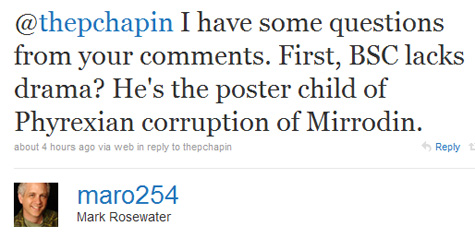
Yeah. I don’t know about you guys, but I was certainly heartbroken when I learned that that iconic character, “Darksteel
Colossus,” the Hamlet of Mirrodin, was being overtaken by the Phyrexian infection. Remember this tremendous character-building soliloquy from
Darksteel?
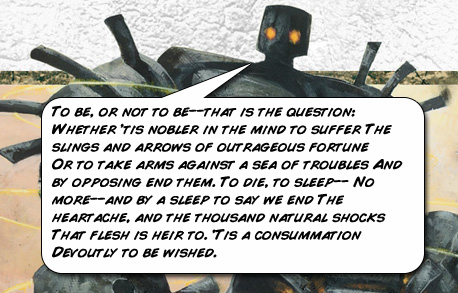
After hearing those words echo forth from his metal frame, I felt closer to Darksteel Colossus and gained a vested interest…
Oh, wait a second. None of that happened. He’s just a giant robot that beats down, with IP support whatsoever or reason why we should care.
Story-wise, nobody gives a Darksteel-plated crap.
Still, I guess I can see why MaRo would declare BSC the poster child for Phyrexian corruption because there’s certainly nobody else in the set
who qualifies…
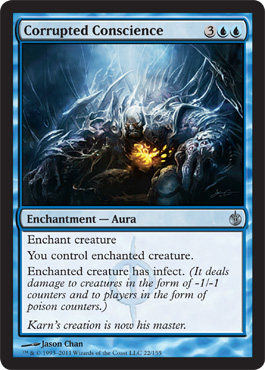
Oh wait.
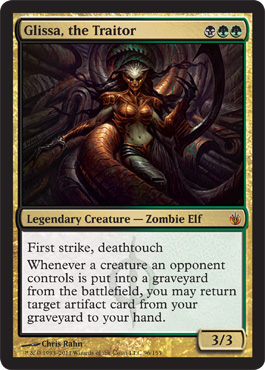
My bad.
I guess I can’t really blame Mark. From a design perspective, Darksteel Colossus is the most important of the three cards/characters, and his
statement that the card is the “poster child” might seem somewhat defensible. However, the idea that the Phyrexianization of Darksteel
Colossus was a crucial linchpin in the design vision seems a little strange to me.
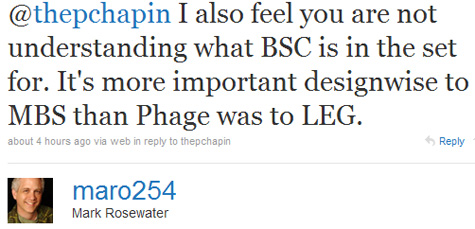
So far we’ve seen Glissa and Karn on Phyrexian watermarked cards. Who’s next to get infected? Urza’s brother, Burza? Richard
Garfield? I think people get it.
I just feel like these tweets are defending the card as a necessary measure, when in fact it was about as necessary as using an AK-47 to kill a
squirrel.
7. Response-wise, WotC is reaping what their glorification of design has sown and now have to defend a meat and potatoes design as
“inspired.”
“Basic senses like sight and taste are reserved for those in power.” – flavor text, Phyrexian Revoker
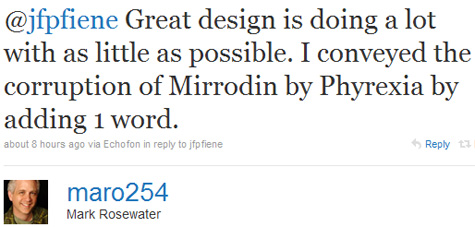
For his next trick, he’s going to be turning Phyrexian glistening oil into wine.
While I certainly still believe that almost all Magic players are terrible at designing cards, I don’t believe that designers possess some
“planeswalker spark” that renders them alone able to perform their duties. Rather than any burst of inspiration, the current, advanced
state of Magic design seems to be the product of trial and error over the long term. Wizards of the Coast knows what works, and under the direction of
someone with enough experience navigating the pitfalls (like Mark Rosewater), just about anyone could be a passable designer.
The Great Design Search 2 is a fun exercise, but as with the first iteration of the contest, it has cast much of WotC’s methodology into the
public eye. For the most part, the judges come off looking pretty good, but nothing can hide the fact that outside of a some key principles, much of
Magic design is just a matter of opinion. From week to week and judge to judge, responses vary greatly.
I feel like if Blightsteel Colossus had been submitted to the judges of GDS2, they would have reamed it.
Now, just for the record…I can appreciate a card like Blightsteel Colossus. I’ve played enough video games where the spell that comes after
Fire is Fire 2. It’s the same card but with one change? Slap “Elite” in front of the name. Or after the name. Next iteration of a
lightning spell? Stick “ra” on the end. Then stick “ga” on the end. Then stick “ja” on the end. Don’t test
me. I’m not going to run out of suffixes.
Colossus Blade not doing it for you? How about Cruel Colossus Blade? How about Cruel Colossus Blade of Quickness?
That’s all this name is and all this card is. It’s nothing more than that. Again, I’m totally fine with that. I have played games and
watched series (generally originating from Japan), the asininity of which knew absolutely no bounds, just because they were grandiose and
“fun.”
What I don’t like is that they just won’t admit that this design can’t hold a candle to something like, say, Doran. (Doran is a good
example doing a lot with a little, not this load of balls.)
Instead, people are staying on-message. They picked the wrong card to “dial up,” but now MaRo is now defending it as the right call:
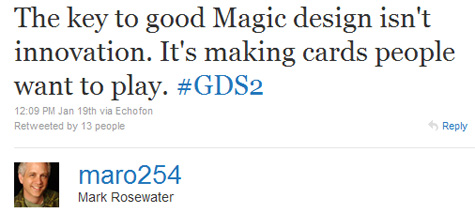
And there you have it.
The key to good writing isn’t innovation, it’s writing words people want to read.
The key to good music isn’t creativity, it’s recording songs that people want to listen to.
The key to good filmmaking isn’t to be groundbreaking, it’s shooting films that people want to see.
This sensibility is why interchangeable boy-bands, James Patterson novels, and movies like Undisputed III exist.
God, we’re lucky that “good, creative design” and “stuff that will sell” are two things that often line up. My faith in
humanity always takes a leap when something brilliant gets the accolades it richly deserves. There have been hundreds of Magic cards printed that were
very inspired—Doran and Form of the Dragon, to name two. When cards like those appear, I’m the first one in line to begin the slow clap.
Blightsteel Colossus, though, is one of the hollowest designs we’ve seen in a long time, ill suited to the limelight it’s been given.
I’m going to play with it.
I’m going to enjoy it.
I get what they were trying to do.
Just don’t try to tell me it’s brilliant or even a good idea.
As I said earlier, it’s uncanny. This card was supposed to represent the Phyrexian act of corrupting something good and pure, to show off the
twisted, alien machinations of a race unfamiliar with any emotions and sentiment tertiary to the ultimate goal of
selling packs
taking over Mirrodin.
Nice work, guys. All hail the Father of Machines. *
Geordie Tait
Geordie_Tait
on Twitter
FP_GLyM on MODO
